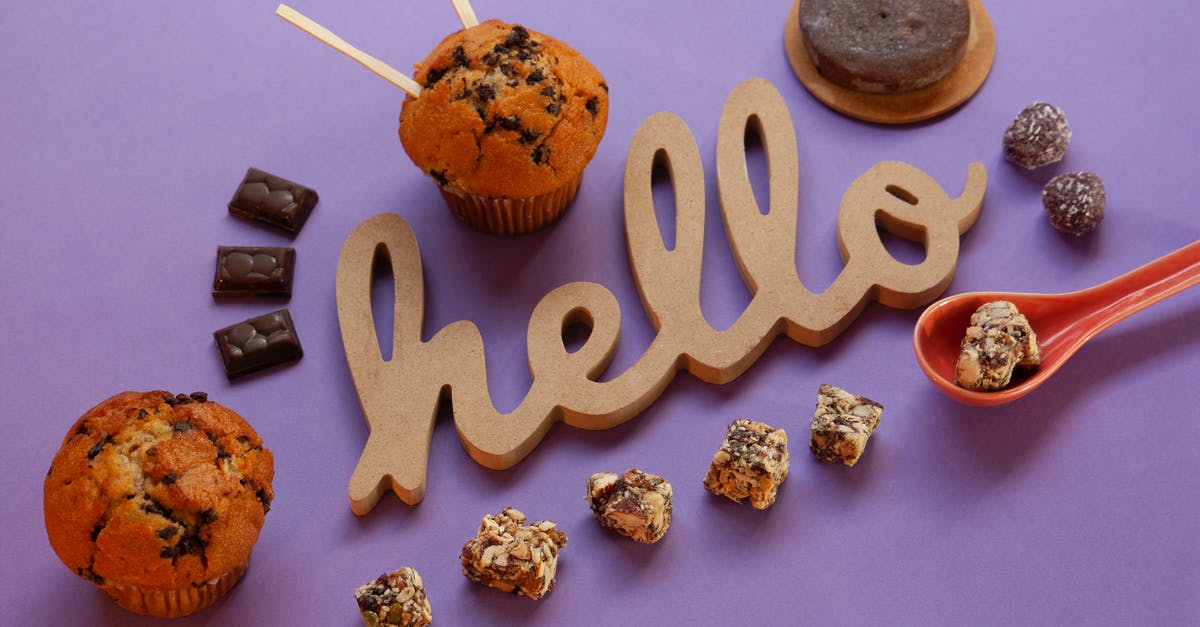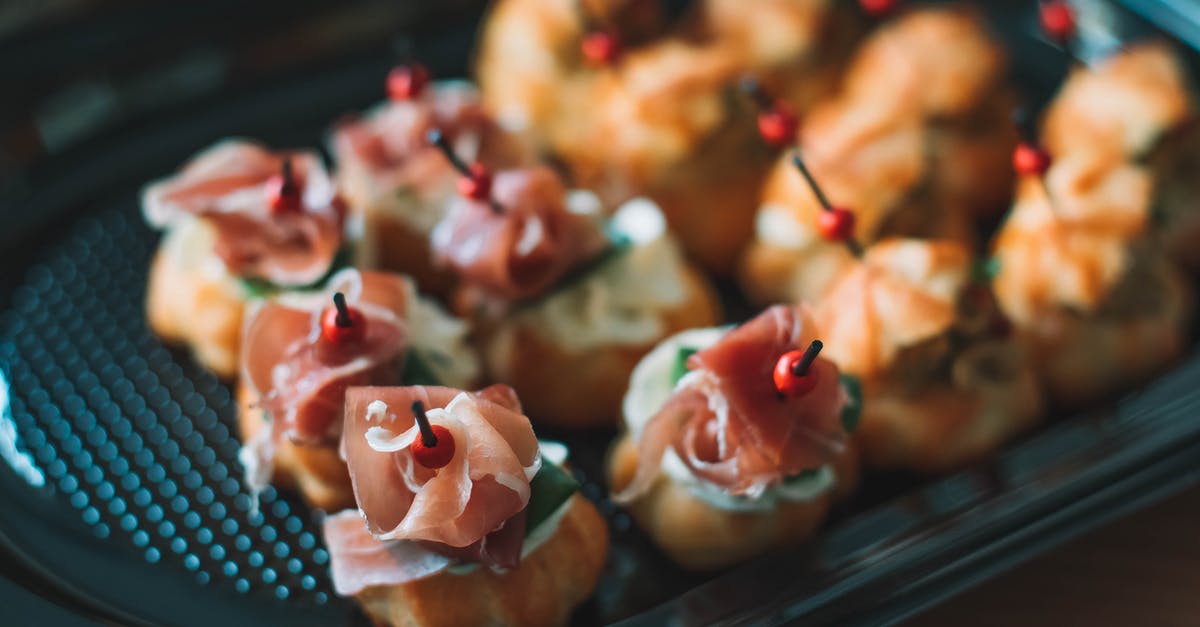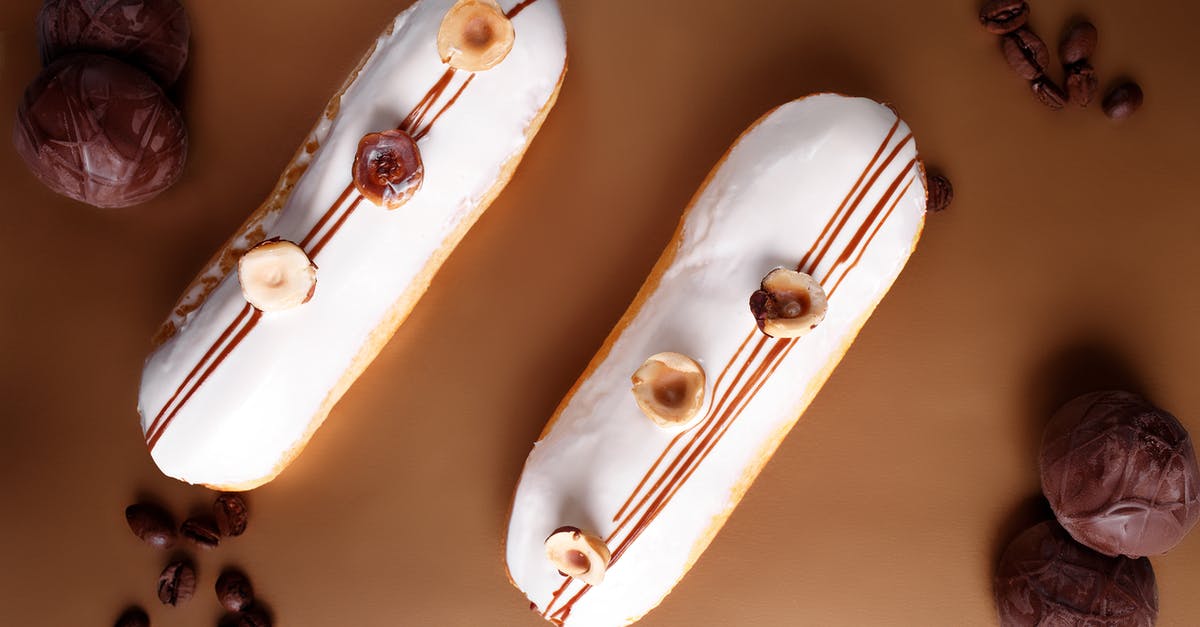Choux pastry (Chocolate eclairs) doesn't rise

Last time I tried to make Chocolate eclairs (similar to cream puffs), the choux pastry just sat in the oven and basically fried.
It didn't rise/grow and so I couldn't hollow out the shells.
Any suggestions?
Recipe was from The Australian Women's Weekly Original Cookbook (Golden Press Pty Ltd, 1977) p. 204
It is almost identical to the one published on their website http://aww.ninemsn.com.au/food/cookbooks/787237/chocolate-eclairs, with the exception that the cookbook recipe used 1C water and 1C plain flour.
Best Answer
It's actually been a few years since I made éclairs, so I might be forgetting a few things, but here are my immediate reactions to the recipe:
"Plain flour" (by which I assume they mean all-purpose flour) is not appropriate for choux paste. You should be using bread flour (AKA "strong flour"), you need the extra gluten for this. That is probably the most important reason why your choux paste didn't turn out right.
The ratio of fat to water is off. You want a 2:1 water:fat ratio. Use 50 g of butter or shortening for every 100 mL of water. For reference, if you're going to adjust the ratio then you also want to use approximately 2.4 eggs per 100 mL of water. The recipe mentioned in the question is close, but slightly short, so be careful if scaling up.
The ratio of flour to water is blatantly wrong, for both the posted recipe and what you say is the cookbook recipe, and you should never ever use volumetric measurements for flour in such a sensitive baking recipe. You want to measure out 75 g of flour per 100 mL of water. For a cup of water that's about 175 g of bread flour. Don't even try to calculate the volume, weigh it. This is extremely important, if you don't use enough flour then the choux paste won't fully gelatinize!
A "pinch" of salt is probably OK at this small scale, but if you ever decide to scale up then you need to be accurate; use 2% salt (2 g per 100 mL of water).
The recipe is correct in warning you against letting any of the water evaporate, and telling you to cook and stir the roux until it clears the side and forms balls when shaken. You should also see a white film on the bottom of the pan.
One thing that the recipe doesn't mention that is extremely important is that you need to wait for the roux to cool before adding the eggs. Whole egg coagulates at 65° C (149° F) so it is absolutely imperative that the roux is cooler than that, otherwise you will end up with scrambled eggs.
Make sure you completely incorporate the eggs. Scrape the sides of the bowl if necessary. And don't try to cut corners by adding all the eggs at once; you really need to add them one at a time, otherwise you'll end up with lumps. Missing this probably won't cause failure to rise, but you don't want lumps, trust me.
When you're done, you should have a paste that resembles the consistency of a meringue, but heavier. That is, it holds its shape, even against gravity, but is still soft enough to spread. I check with my finger. If it's too stiff, you can add milk to soften it, but if it's not stiff enough, then you didn't get enough of the flour gelatinized and your paste is ruined. (So don't overmilk!)
I don't agree with their "very hot oven, then lower the temperature to 180° C" instruction. 180° C is a very low temperature for baking choux paste, and I don't think that the 10 minutes of "very hot" temperature (whatever that is) are going to compensate for it. I have always baked choux paste shells at a straight 200° C (390° F) for 30 minutes.
That's about it for tearing apart their choux paste recipe. I'm not even going to touch their "custard cream" recipe, which is just not even remotely close to the chantilly cream that éclairs are supposed to have.
Pictures about "Choux pastry (Chocolate eclairs) doesn't rise"



Quick Answer about "Choux pastry (Chocolate eclairs) doesn't rise"
Common problems: Failure to rise There are two common problems encountered when making choux pastry. Firstly, if you add the eggs to your hot water and flour mixture before it has cooled, the eggs will cook in the paste and refuse to rise in the oven.Why are my eclairs not puffing up?
If they were soggy to start with, then they will not rise properly. But even if they do rise, they will deflate when they cool down, due to too much moisture inside the shell, especially if you take them out of the oven too soon.Why are my cream puffs not rising?
Do not open the oven too soon or it may cause the puffs to collapse or not rise at all. They should be nice and golden brown on the top when done. Remove from the oven and allow them to cool while you make the sweetened whipped cream.What helps choux pastry rise?
Choux pastry leavens by steam. The huge amount of liquid in the choux paste evaporates to steam, expanding the egg protein, causing the rise in the puffs.Best Chocolate Eclair Recipe
More answers regarding choux pastry (Chocolate eclairs) doesn't rise
Answer 2
Crullers are fried pâte à choux dough. When baked, rather than fried, this same dough can be used to make éclairs and cream puffs. A generous poof, in either form of cooking, comes from having the right balance between dough consistency and steam formation.
Pâte à choux creations are somewhat unique in that they are cooked twice - once during the mixing of the dough - once in the frying or the baking.
Recipes for the dough vary a little bit, but basically rely on using equal parts water and eggs with half as much butter and flour (by weight). Some recipes use half water and half milk (my preference). OK, sure there might be other ingredients in minor roles - salt, sugar, spice - but the basic ingredients are liquid, butter, flour, egg.
It's difficult to diagnose a problem without knowing your recipe or technique but I'll try to give a few pointers. After you bring the water and butter to a simmer (easy with the heat), add your flour and stir constantly - the way to tell when this cooking is done is not by time, but by observation - remove your paste from the heat when you can see the paste pulling away from the sides of the pot. There is a point of equilibrium in the process where sufficient water has been absorbed by the flour and a little water has been driven-off as steam - when this equilibrium is reached, the paste in the pot will visibly pull away from the pan as if there were some strange repellent force there.
Next, some recipes call for you to transfer the hot paste to a stand mixer - I have always mixed the eggs in by hand (mixing in by hand give me a better feel for the consistency of the finished dough). Add-in the eggs one-at-a-time and with constant stirring to fully incorporate in stages. My own preference here is to combine all the eggs in a separate bowl and beat them together first then pour the egg slowly into the paste while stirring vigorously.
Now, as far as dense crullers are concerned, my guess would be that one of three things happened - either you were heavy-handed with the flour or your failed to cook the water/butter/flour paste long enough or you didn't add enough egg to get a smooth, easy-to-pipe dough. Your dough should not drip off your spoon, but it should be fluid enough to pipe very easily when you use the piping bag to extrude your crullers. If your dough is not sufficiently fluid, it cannot expand from the steam inside to create the desirable poof.
My recommendations: Use bread flour if you didn't before (AP flour will work, I prefer bread flour), consider replacing half of your liquid with milk (totally optional - just offering another personal prejudice here), and consider weighing-out your flour if you used a volumetric measure before. Keep in mind that you need to shoot for equal parts liquid and egg, with half that amount of butter and flour (by weight) - for example 8 oz. water (1 C), 4 oz. butter (8 Tbsp.), 4 oz. flour (if your recipe calls for a cup, my cups of flour always weigh more than 4 oz.), and 4 or 5 eggs (about 8 oz. worth).
Finally - keep adding egg until the dough consistency is right even if you have to add more egg than the recipe calls for. If you don't have a scale to weigh-out your flour, go ahead with your volumetric measure but be aware that you might need to add some extra egg to your dough to get a smooth and fluid consistency - and if you add extra egg here, remember that a whole extra egg might be too much - beat a whole egg before adding it to your dough so you can incorporate it in stages to get you a consistency that you can easily pipe-out.
Answer 3
I just came across your question regarding the chocolate eclairs and the secret is the water and butter has to be boiling rapidly when you put the flour in. I know this as I have had disasters as well, but now I am a pro.
Answer 4
yes I agree the water and butter must be boiling then add the flour and stir briskly with a wooden spoon then wait for the paste to come away from the side of pot before taking off the heat add eggs 1 by 1 whisking briskly with a wooden spoon for each egg I leave the paste in the pot and use a spoon to put the mixture onto a greased oven tray choux cooks within 20-30 mins should be puffed and light when cool fill with whipped cream and chocolate icing - DEVINE!!!
Sources: Stack Exchange - This article follows the attribution requirements of Stack Exchange and is licensed under CC BY-SA 3.0.
Images: Valeria Boltneva, Nikita Krasnov, Karen Laårk Boshoff, Abhinav Goswami
